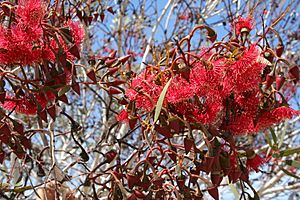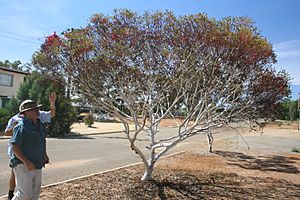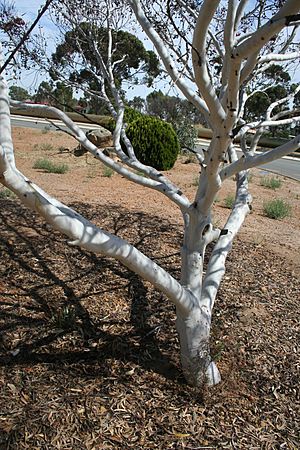Red-flowered mallee facts for kids
Quick facts for kids Red-flowered mallee |
|
|---|---|
 |
|
| Eucalyptus erythronema flowers and foliage | |
| Scientific classification | |
| Genus: |
Eucalyptus
|
| Species: |
erythronema
|
| Synonyms | |
|
Eucalyptus conoidea Benth. Eucalyptus conoidea Benth. var. conoidea |
|
The Eucalyptus erythronema, often called the red-flowered mallee, is a special type of mallee (a small tree or shrub) or a tree. It grows only in Western Australia. This plant has smooth bark that changes color from dark pink or red to whitish as it peels off. Its adult leaves are shaped like a spear, and its flower buds hang down in groups. The flowers can be red or yellow, and the fruit looks like a cone.
Contents
What it Looks Like
The Red-flowered mallee is a small tree or shrub that usually grows between 2 and 6 meters (about 6.5 to 20 feet) tall. It has a special woody base called a lignotuber that helps it regrow after fires.
Bark and Leaves
The bark of this plant is smooth and can be pinkish-brown to dark red. When the old bark peels off, it shows new, powdery, creamy-white bark underneath. Its adult leaves grow in an alternating pattern along the stem. They are green or olive green on both sides and are shaped like a spear. These leaves are usually 50 to 80 millimeters (about 2 to 3 inches) long and 7 to 15 millimeters (about 0.3 to 0.6 inches) wide. They grow on a slightly flat stalk called a petiole, which is 5 to 13 millimeters (about 0.2 to 0.5 inches) long.
Flowers and Fruit
The flower buds grow in the axils (the angle between a leaf and the stem) of the leaves. They usually appear in groups of three, but sometimes in groups of seven. These buds hang down on a thin, unbranched stalk called a peduncle, which is 10 to 27 millimeters (about 0.4 to 1.1 inches) long. Each individual bud has its own small stalk, called a pedicel, about 10 to 18 millimeters (about 0.4 to 0.7 inches) long.
When the buds are mature, they are wide and spindle-shaped, measuring 9 to 23 millimeters (about 0.35 to 0.9 inches) long and 7 to 10 millimeters (about 0.28 to 0.4 inches) wide. They have a cap-like cover called an operculum that can be cone-shaped or look like a beak. The Red-flowered mallee blooms between July and December, or from January to February. Its flowers can be red, pink, or creamy white. After flowering, it produces woody, hanging, cone-shaped fruits called capsules. These fruits are 6 to 14 millimeters (about 0.24 to 0.55 inches) long and 10 to 14 millimeters (about 0.4 to 0.55 inches) wide.
Plant Classification and Naming
The Eucalyptus erythronema was first officially described in 1852 by a botanist named Nikolai Turczaninow. He wrote about it in a science journal after James Drummond collected a sample of the plant.
In 2012, two scientists, Dean Nicolle and Malcolm French, identified two slightly different types (subspecies) of Eucalyptus erythronema. These types are now officially recognized:
- Eucalyptus erythronema subsp. erythronema: This subspecies has waxy branchlets (small branches) and usually red flowers.
- Eucalyptus erythronema subsp. inornata: This subspecies has branchlets that are not waxy, and its flowers are pale creamy yellow.
The name erythronema comes from two ancient Greek words: erythros, meaning "red," and nema, meaning "a thread." This name refers to the red stamens (the parts of the flower that produce pollen) of the plant.
Where it Grows
The Red-flowered mallee is found in the southern part of the Wheatbelt region in Western Australia. It grows in areas with shrubs and open woodlands. You can find it in sandy-clay soils that often have lateritic gravel (a type of reddish soil). Its range stretches from near Wongan Hills to Corrigin and as far east as Southern Cross.
Conservation Status
The Western Australian Government's Department of Parks and Wildlife has classified this eucalypt as "not threatened." This means it is not currently at risk of disappearing.
Uses of the Plant
This plant is popular in gardening because it grows at a moderate speed and thrives in full sunlight. You can buy its seeds or young plants from nurseries.
Horticultural Uses
People use the Red-flowered mallee for several reasons:
- Ornamental plantings: It makes a beautiful addition to gardens and landscapes.
- Honey production: Its flowers attract bees, which helps in making honey.
- Tannin products: The plant contains tannin, a substance used in various industries.
- Screening plant: It can be planted to create a natural screen or hedge.
It is also easy for its seeds to sprout, and the plant is good at surviving dry conditions, making it drought resistant.



